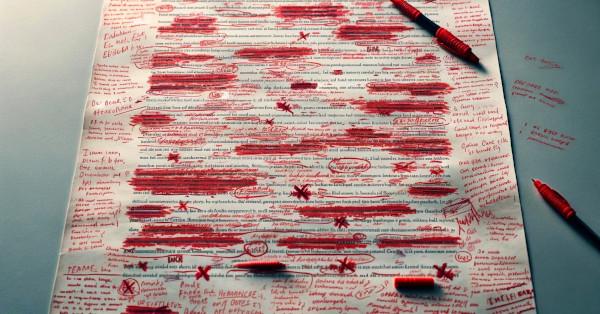- Published on
My Writing Journey
- Authors

- Name
- Josh Haines
- @joshhaines
Learning to Write via Red Ink
Although I did well in my English classes in school, I was generally just a little better than average at writing with probably a B+ average. I tested out of the only required writing class in college so I started work with no formal training past high school.
My first job out of college (circa 2007) was doing failure analysis at Honeywell Aerospace. Failure analysis consists of investigating the root cause of aircraft part failures and writing reports about them. Our team would section the parts, examine them with microscopes, and perform other types of analytical tests to help us determine the reason behind the failure. Our failure reports ranged from five to thirty pages and included pictures, diagrams, and tables. These reports are read by varying audiences including internal engineers, customers, suppliers, and even legal teams. Failed aircraft parts tended to get people pretty excited. We would need to consider liability, improper manufacturing, or other difficult situations. The Point: the reports needed to be well-written.
My mentor throughout my time at Honeywell was a Sr Materials and Process engineer named Randy who would review all my reports. I'll never forget the first report Randy reviewed. I'm pretty certain he went through multiple red ink pens on that five page document. Over time, I slowly learned and got better meaning less and less red ink. It was throughout my seven years at Honeywell that I truly learned technical writing to an above average level.

From Writing for Engineering to Writing for Tech
Zooming forward to 2017, I was a Sr. Materials Engineer for Rolls-Royce. During this time I was doing small bits of writing for things like supplier audits, Root Cause & Corrective Action (RCCA) efforts, and of course millions of emails. Although I was doing real engineering work, my reports were rarely over a page or two. I wasn't doing any other lengthy writing.
As described in my article on the history of the Software Factory, by 2019 I was working more with software and had mostly left materials engineering work behind. As part of this work I began spending more time writing again. I was creating training for new citizen developers, documentation for applications, newsletters for the team, and even things like compliance documents for our compliance stakeholders. Unfortunately, I wasn't able to directly apply my writing experience to this new style of writing.
Technical writing in the software world feels both the same and different than technical writing in the engineering world. In both worlds we tend to value short sentences, simple grammar, and precise vocabulary. Unlike engineering writing, however, software related technical writing is aimed to inform, excite, guide, and support users towards a goal. Technical writing is often less formal and you generally need to include ways to keep the reader's attention. An engineering report can be as boring as you like because people are reading it because they have to read it.
Writing as a Superpower
Amazon is a company known to have a strong document and writing focused culture. I've talked before about a fantastic book called Working Backwards which goes into detail about some of the decisions and culture items at Amazon. One of those items is the Amazon six page document. There are many good articles about these documents (like here and here!) which explain them better than I can. In a nutshell, these decision documents are used to offer and gain consensus on an idea or strategic direction. Unlike Amazon, most companies use slide decks for this purpose which are more of a sales tool. They also allow for lazy thinking via short bullet points.
I have now written a few six-pagers to accomplish things like lay out a decision, formalize a strategy, or convince people of a technical direction. To do them well takes a commitment in both time and research as your thoughts must be both well reasoned and well written. My love for this document format and its capability is equally balanced by my hatred for slide decks and all they represent.

The more I began to write at work, the more I realized that people around me were not writing much aside from emails. Email in my company remains strong as our main method of communication internally. Plenty of teams still write Word documents for official reports and documents. That said, it feels like teams are spending more time in PowerPoint slide decks than ever before. Strategic documents and meetings tend to be people sharing PowerPoint decks with little actual content. It is frustrating how often there are meetings about PowerPoints and then PowerPoints about the meetings. This path leads to the dreaded "crowdsourcing of ideas and decisions." According to Jeff Bezos, "Meetings should be about gaining consensus." People willing to communicate through well-crafted and well-written documents are very rare.
All of this felt like an opportunity to take my writing to a new level. I'm now at a point in my career where I'm doing more thought leadership. Sharing my thoughts on topics and strategic decisions via long-form writing is more powerful and effective than any other method I've tried. Being able to write my thoughts clearly also helped me to think more clearly. It was beginning to feel like writing was a superpower.
Jordan Peterson as a Writing Champion
It was around this time that I saw a YouTube Video of Jordan Peterson talking about his writing method. That video led me down a rabbit hole of other videos of Jordan discussing reasons for writing, how it helps you organize your thoughts, and how it can support various aspects of your life. This all aligned well to my career goals including thought leadership and technical documentation described above.
NOTE
Jordan Peterson can be divisive. Aside from his work on writing, authoring books, and working as a clinical psychologist, he is involved in politics. I would strongly recommend not letting your agreement or disagreement with his politics prevent you from the valuable work he has done in the sphere of writing. His discussions on writing as a life-changing skill are truly fantastic.
In one of the writing videos, I recalled hearing Jordan discuss an app that would help writers by enabling them to easily use his writing methods. A video about that app was recommended which led me to realize the app was now live and available to be used. It's called Essay.app and I'm using it to write this article.
Essay.app as a Writing System

I'm currently drafting this article on the last day of my 2-week trial that is offered by the essay app. Overall, I'm really pleased with it. It enables and empowers the user to take you through all the steps Jordan recommends for proper writing. They also provide a writing guide that makes learning and understanding the method more clear. This guide can be accessed even without paying for a subscription to the app. At this point I've used the app to draft personal blog articles, book reviews, work documents, and even a couple six-pager documents.
I feel like the quality of my writing has improved even in the short time I've used this app. I hope it can help me to create content both personally and professionally at a level than I have achieved before.
Wrap-Up
I'm hoping that when I re-read this article in a couple years I'll be able to see this moment as a time when my writing took another great leap forward, similar to the years reading red-ink notes at Honeywell. I'll make a goal to update this and see if the higher-quality decision documents led to improved goal achievement and better thought leadership at work.
I would highly recommend the Working Backwards book, the Essay.app writing tool, and to spend some time writing about things that interest you. I would also recommend taking the time to listen to Jordan explain why writing is such a powerful tool, this video does it as well as any.
